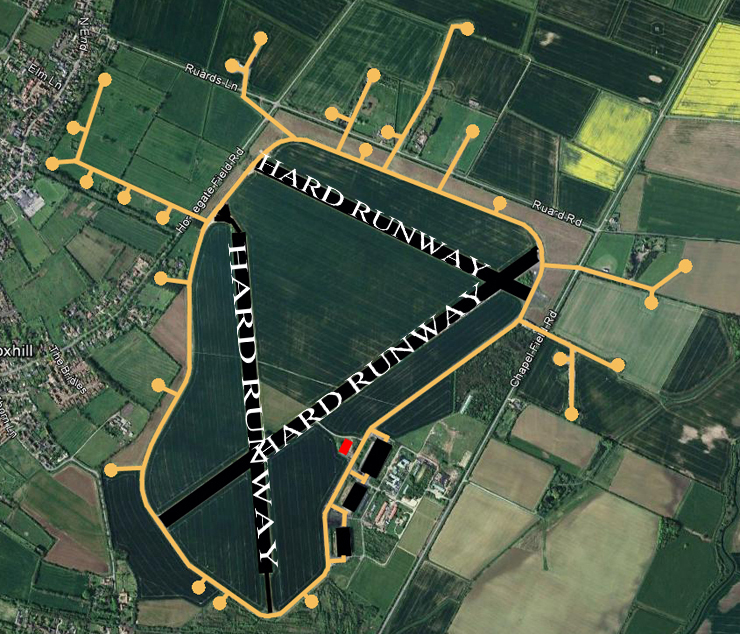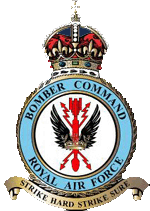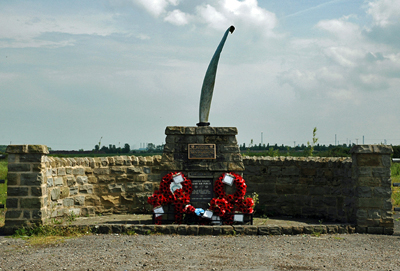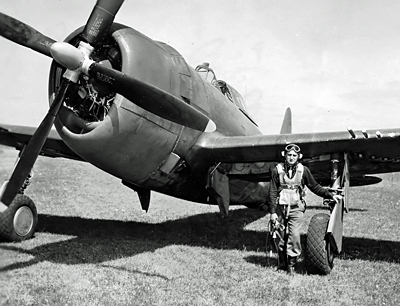Goxhill Airfield History

(Map edited to show the airfield and runways 1940-45)

© Crown Copyright/MOD 2010
53°40'46.6"N 0°18'58.9"WRunways:
01/19 & 12/30 4200ft x 150ft & 07/25 6000ft x 150ft
The history of Goxhill can be dated back as far as 30th April 1916, when reference was made on a war office map to an RFC Landing Ground at Goxhill. But to date no other material has emerged to support this, but it is believed that the WWII airfield was built somewhere within the proposed Landing Ground.
Construction first began at the airfield in early 1941 with three hangars being built, two T2’s and a single J-Type. Four blister and fifty aircraft hardstands were also built to compliment the standard ’A’ runways. Accommodation at the station was built to house a combined 1700 personal.
The airfield finally opened on 26th June 1941, under the control of 1 Group, Bomber Command.
The first use of the airfield was to house the newly established 1 Group Target Tow Flight, which had been formed on the 5th August 1941 at Binbrook. But due to a lack of space at Binbrook the decision was made to move them to Goxhill, and move them back to Binbrook again at a later date. The flight officially formed at Goxhill on the 18th September 1941 and with it brought the first aircraft to the station in the form of the Westland Lysander.
The first two Lysanders to arrive at Goxhill touched down on the 25th October, but only one made a successful landing. On landing one of the Lysanders overshot the runway and tipped on its nose, causing minor damage which was later repaired. But despite only just receiving its first aircraft the flight soon left the airfield, and returned to Binbrook on the 10th November.
With the station now void of any active personnel and aircraft, control was transferred to 12 Group, Fighter Command in December 1941. But even with this change of control the airfield was still deprived of active squadrons and aircraft. January 1942 saw a ten day period of activity in the form of a trials programme for a number of Supermarine Spitfires from No.616 Sqdn, but no other activity after. The following month saw the airfield allocated for use by No.15 (P) AFU based at nearby Kirmington, but again no active aircraft or personnel arrived.
With the airfield now sat empty again an agreement was struck with the US military, and in May 1942 control of the airfield was passed over to the US 8th Army Air Force, although the formal handover of the airfield was not to take place until the August. This was to be the first airfield in England to be solely controlled by the US military during the war, and on the 10th June 1942 the first Americans began to arrive.
The idea behind the change of ownership was to allow the Americans to establish a fighter aircraft training base, and personnel would arrive directly from America. The pilots would then embark on a variety of courses to enable them to operate effectively in Europe.
The first to arrive were the Headquarters Unit closely followed by the 71st Fighter Sqdn, both under the control of the 1st Fighter Group. With them came the first American aircraft in the form of the Lockheed P-38 Lightning which started to arrive the following month. The 9th July 1942 saw the first American aircraft land at the airfield, which had flown directly over from the United States.
A big ceremony was planned for the handover of control in mid-August. But the ceremony suffered a setback due to an attack on the airfield by the Luftwaffe. The ceremony was to be attended by Air Marshall Sir Charles Portal and General Dwight D. Eisenhower, but even the attack did not stop the ceremony. Incidentally this attack not only failed in the sense the single bomb dropped failed to explode, but it was also the only attack on the airfield during the entire war.
Over the next few years many American squadrons and aircraft would come and go from the airfield. The squadrons would stay for 2-3 months training, and then depart for active duty at various stations across England. It was planned out that as one squadron left the airfield, the next would arrive, and with all the comings and goings a variety aircraft would also grace the airfield. Both the Bell P-39 Airacobras of the 81st Fighter Group and the Republic P-47 Thunderbolts of the 353rd Fighter Group to name a few, along with a number of squadrons flying the Supermarine Spitfire.
The 20th January 1945 saw the airfield handed back to the RAF and immediately the station was placed on Care and Maintenance until the end of the war, under the control of Kirton-in-Lindsey. But the control of the airfield was short lived, and the control was transferred again, this time to Maintenance Command on the 27th May 1945.
Like all other airfields across the country, Goxhill had its fair share of fatalities. In total 23 people were killed and 53 aircraft lost. In one incident three Spitfires were destroyed in a single incident on the 28th October 1942, killing all three pilots.
With the war now over the station was kept on Care and Maintenance until 1948, when sections of the accommodation area were requisitioned and allocated to the Ministry of Health for emergency use. Maintenance Command also used the airfield for storage of excess munitions amongst other things, and it remained a storage depot until the station was finally closed on the 14th December 1953.
Now fully closed, the airfield was leased to the local farmers for agricultural use until the land was finally sold-off by the MoD on the 29th January 1962.

© Richard E. Flagg - Goxhill memorial 2010
With the airfield no longer under military control, it had has fared very well and remains pretty much still intact, and still has an air about it. Since closing the hangars have been used as a Home Office Supply Depot amongst other things. At one point the hangars were even used to store ‘Green Goddess’ fire engines.
The majority of the buildings in the Technical site, with the exception of the control tower which was demolished in 2002, are still standing, although looking a bit worse for wear. The main J-type hangar and two T2 hangars are still standing, as well as many smaller buildings, although the runways and perimeter tracks were removed in the late 1990s and used as hardcore on local roads.
A memorial has been erected on the North-West corner of the airfield which incorporates a propeller blade from a crashed Lockheed P-38 Lightning. The aircraft belonged to 2nd Lt Lane A. Ferrara, and he sadly lost his life when the aircrafts engine caught fire just after take-off, causing the aircraft to nose dive in to the ground on the 26th May 1944.
Overall, most probably due to its location, the airfield has remained pretty much untouched and still has that war time atmosphere about it.
| Date | Squadron | Notes |
|---|---|---|
| June 1941 | RAF Goxhill opens under the control of 1 Group, RAF Bomber Command. | |
| September 1941 | 1 Group TTF | Operating the Westland Lysander. The Target Tow Flight left Goxhill on 10th November 1941. |
| December 1941 | Airfield transferred to 12 Group, RAF Fighter Command. | |
| January 1942 | No.616 Sqn (Det) | Operating the Supermarine Spitfire. The squadron left the station on 25th January 1942. |
| May 1942 | No.15 (P) AFU | Despite being in control of the airfield, no active aircraft were stationed at the airfield. |
| June 1942 | RAF Goxhill transferred to USAF 8th Air Force | |
| June 1942 | 1st FG USAF | Operating the Lockheed P-38 Lightning. The Fighter Group left Goxhill 24th August 1942. |
| August 1942 | 52nd FG USAF | Operating the Supermarine Spitfire. Left the airfield on 29th October 1942. |
| October 1942 | 81st FG USAF | Operating the Bell P-39 Airacobra. Left the station on 15th November 1942. |
| December 1942 | 78th FG USAF | Operating the Lockheed P-38 Lightning and Republic P-47 Thunderbolt. Left Goxhill on 1st April 1943. |
| January 1943 | 52nd FG USAF | Operating the Republic P-47 Thunderbolt. Left the station on 5th April 1942. |
| June 1943 | 353rd FG USAF | Operating the Republic P-47 Thunderbolt. Left the airfield on 5th August 1943. |
| August 1943 | 356th FG USAF | Operating the Republic P-47 Thunderbolt. Left the station 12th October 1943. |
| October 1943 | 358th FG USAF | Operating the Republic P-47 Thunderbolt. Left Goxhill on 3rd December 1943. |
| December 1943 | 496th FTG USAF | Operating the Lockheed P-38 Lightning, North American P-51 Mustang, Westland Lysander and Miles Master. Left the airfield on 15th February 1945. |
| January 1945 | Station transferred back to RAF Fighter Command. | |
| May 1945 | No.233 MU | No.233 Maintenance Unit left Goxhill in December 1953. |
| April 1945 | No.35 MU | No.35 Maintenance Unit left Goxhill in September 1950. |
| December 1948 | No.93 MU | No.93 Maintenance Unit left Goxhill in June 1951. |
| September 1952 | No.92 MU | No.92 Maintenance Unit left Goxhill in December 1953. |
| December 1953 | RAF Goxhill deactivated and closed. |

